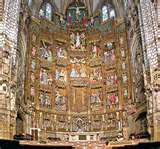 |
| Toledo at sunset |
We were now ready to see the sights of Toledo. We met our guide at Zocodover square and set up a plan to see the city. We would not be going to the Alcazar as it is now used for the military. As previously mentioned, Toledo has done a great deal of renovations to prepare for tourist. The Alcazar was a huge renovation project since it was almost destroyed during the Spanish Civil War. The story goes that in 1936 Colonel Moscado gathered all the military personnel in the Toledo district and the Civil Guard and barricaded themselves in the Alcazar to hold down the fort against the Nationalist. they had ammunition but little food and the determined leadership of Colonel Moscardo. The fighting went on for ten weeks almost to the point of starvation while the Nationalist bombed the walls and dropped bombs on the Alcazar. Although the fortress was almost destroyed, the Nationalist still had to climb the hill to overtake the fort which they didn't do. Just in time Franco's troops came and fought off the Nationalists. By the 1960s the Alcazar was rebuilt and assumed its position as the landmark that is seen standing in its glory today.
 | |
| Our guide was ready to lead us through the streets of Toledo. |
 | ||||||
| Banners of cloth are strung to protect people from the hot sun during the Festival. |
 |
| Jean has her camera ready to take pictures of the clean streets. |
We walked until we came to the Catheral of St. Mary of Toledo. It was built in the 13th Century during the rule of Ferdinand III and was modeled after the French style of the Bourges Cathedral. Like many other cathedrals it was built on the same site of the Muslim mosque. Its high Gothic style is made from white limestone from quarries near Toledo. We had seen our share of cathedrals so far but we would be very surprised at this cathedral because of the paintings by El Greco and other unique structures.
There are five parts of this cathedral that are outstanding: The Choir, the Main Altar, the Transparente, the Monstrance and famous paintings. The choir circling the back part of the cathedral can accommodate a chorus of eighty priests who chant during the Mass. The lowest level is decorated in carved miserichords which are half-seats that can be propped up when the service is long and leaned against so that the singer seems to be standing up while he is actually sitting down.
Near the top the below the balcony is a row of carved standing figures from the Bible.
Before leaving the choir, we all took notice of the smiling Virgin. It is a rare marble statue of the standing Virgin and Child which faces the altar. She wears a white robe and is known as the White Virgin. They say that she was a gift of St Louis, King of France, in the thirteen century. What is curious is that both she and Jesus have very dark faces, and are both smiling maybe to look more Moorish since this was once a mosque!
In the chapel of the Sepulchre the retable rises to a great height above the altar. It was commissioned by Cardinal Cisneros in 1497 Mary architects, painters, and sculptures took part in its creation. It includes beautifully craved filigree of balusters, spires, done by Joan Peti. It consists of five continuous panels with the center panel being the widest. It is five stories tall and the lines of separation are stair-stepped. These pictures tell the story of Jesus for the majority of people who could not read. The themes of the central panel from bottom to top are first the Virgin and Child, then the Nativity, and then the Ascension. the top culminates in the monumental scene of Christ's crucifixion at Calvary. Further themes of the life and passion of Christ are represented on the other panels.
In the cathedral there are separate chapels. In the Mozarabic chapel the dome was designed by the son of El Greco, Jorge Theotocopoulus. In addition to the composition, Cardinal Cisnero commisioned Juan de Borgona to depict highlights of the conquest of Oran.
One of the most unique parts of the Cathedral is the altarpiece called El Transperente.
It is a Baroque style combining sculpture and fresco depicting the Mother and Child. High above is the Last Supper with thirteen full sized polychrome marble celebrants. then at the very top among whirlwind of angels and clouds is the ascension of the Virgin Mary.The art work was created by Narciso Tome and his four sons (two architects, one painter and one sculptor.) The name refers to the large skylight that illuminates the high altar. Another hole cut into the back of the altarpiece allows shafts of sunlight to strike the tabernacle.
Enrique de Arfe, a German metalworker from Cologne, worked on his masterpiece for seven years. It was commissioned by Cardinal Cisneros to depict a Gothic temple with columns, arches, vaulting, and delicate lacework. It has 260 statuettes from scenes from the life of Jesus.
 |
| The Monstrance |
The paintings in this Cathedral are outstanding. First to note is El Greco's painting of The Disrobing of Christ found in the Sacristy of the Cathedral. He used color as a significant part of his paintings.
 |
| The Disrobing of Christ by El Greco |
Now I know why they say, "Holy Toledo!"












No comments:
Post a Comment